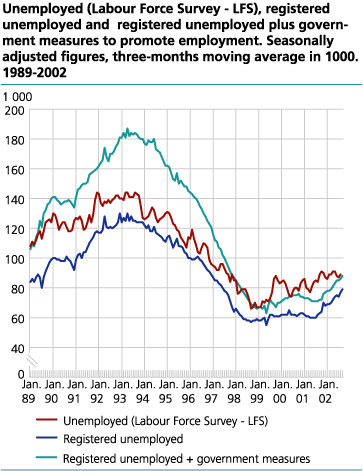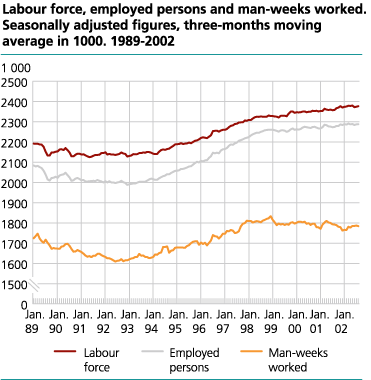Content
Published:
This is an archived release.
More female part-time workers
According to seasonally adjusted figures from the Labour Force Surveys (LFS) only small changes occurred in total employment and unemployment between the second quarter 2002 and the third quarter 2002. Compared with the third quarter 2001, however, the number of employed persons increased by 13 000 persons, and the unemployment increased from 3.6 to 3.8 per cent.
The labour force participation increased among females aged 16-24 and 55-74 between the third quarter 2001 and the third quarter 2002. The growth in female employment concerns part-time employment. In the third quarter 2002 42 per cent of the employed females had a part-time job, compared with 10 per cent among males.
More employees in health and social work
Compared with the third quarter 2001, there was a considerable increase in employment within health and social work. Transport and communication, renting and business activities, on the other hand, showed a decline in employment.
Unemployment at 3.8 per cent
A total of 91 000 persons were unemployed in the third quarter 2002, accounting for 3.8 per cent of the labour force, compared with 3.6 per cent the same quarter 2001.
The rate of long-term unemployment increased from 15 to 20 per cent last year. Long-term unemployed are those who have been continuously unemployed for more than six months at the time of the survey.
There were 74 000 underemployed in the third quarter 2002, i.e. part-time employed seeking more work. As a percentage of all part-time employed, this corresponds to 12.8 per cent, compared with 12.2 per cent the same quarter 2001.
Unemployment in EU and OECD: 7.7 and 6.9 per cent
While the seasonally adjusted unemployment rate in Norway remained stable at 3.8 per cent from May to August 2002, it increased from 7.6 to 7.7 per cent as an average in the EU. The rate in the OECD-countries remained stable at 6.9. In August 2002 the unemployment rate was 5.7 in USA (5.8 in May 2002), 4.8 in Sweden (5.0 in May), and 4.3 in Denmark (4.2 in May).
Increased temporary employment
The number of temporary employed amounted to 226 000 in the third quarter 2002, 15 000 more than the same quarter 2001. This corresponds to 10.6 per cent of all employees, compared with 10.0 per cent one year before. The rate of temporary employment was highest in health and social work, hotels and restaurants and in education, lowest in manufacturing and construction.
Uncertain seasonally adjusted figures
Quality tests show that the seasonally adjusted LFS unemployment figures are uncertain. The seasonal-adjustment method has problems identifying a seasonal pattern for this series of figures. The random component is relatively large compared to the seasonal component; hence one must keep in mind that the unemployment figures contain a particularly high degree of uncertainty. For more information about the seasonally adjusted figures, see separate article .
Tables:
- Table 1 Population aged 16-74 in the labour force, man-weeks worked, registered unemployed persons and persons employed by government measures. 1000 and per cent
- Table 2 Population aged 16-74 år in the labour force, employed persons and unemployed persons by sex (LFS). 1000 and per cent
- Table 3 Persons in the labour force and employed persons by age and sex (LFS). 1 000 and per cent
- Table 4 Population aged 16-74, employed persons by settled/usual working hours per week(1) and unemployed persons by age and sex (LFS). 1000
- Table 5 Persons in the labour force by age and sex. 1000 and as per cent of all in each group
- Table 6 Employed persons by sex and settled/usual working hours pr week (LFS). 1 000
- Table 7 Population aged 16-74 by main activity, part-time employment1 and age (LFS). 1 000
- Table 8 Employed persons by major industry division. 1000
- Table 9 Number of man-hours worked per week1, by industry division (LFS). 1 000
- Table 10 Employed persons,total, and employed persons at work by status and sex. Number of man-hours worked and actual working hours per week (LFS)
- Table 11 Population aged 16-74, employed persons, temporary absence from work and reason for absence, by sex(1). 1000 and per cent
- Table 12 Employees with temporary jobs, by major industry division (LFS). 1000 and as per cent of all employees
- Table 13 Unemployed persons by sex and age (LFS). 1000 and per cent
- Table 14 Unemployed persons by duration of job search (LFS). 1000 and per cent
- Table 15 Unemployed persons by main activity (LFS). 1 000
- Table 16 Unemployed and underemployed persons, by sex and desired working hours per week. Number of man-weeks (of 37,5 hours) supplied (LFS). 1000
- Table 17 Persons aged 16-74 years by labour force status, seasonally adjusted, three-months moving average. 1000
- Table 18 Persons in the labour force by sex and region (LFS). 1 000 and in per cent of total
- Table 19 Employed persons by sex and region(LFS). 1 000
- Table 20 Employed persons by sex and regions (LFS) as per cent of all inn each group
- Table 21 Employed persons, by major industry division and region (LFS). 1997-2001. 1000
Contact
-
Arbeidsmarked og lønn
E-mail: arbeidsmarked@ssb.no
-
Erik Herstad Horgen
E-mail: erik.horgen@ssb.no
tel.: (+47) 93 08 68 62
-
Håvard Hungnes Lien
E-mail: havard.lien@ssb.no
tel.: (+47) 40 90 26 06


